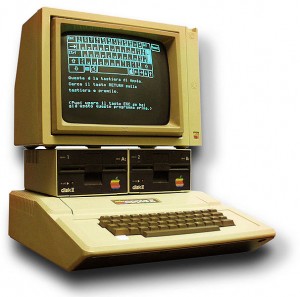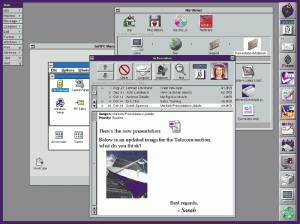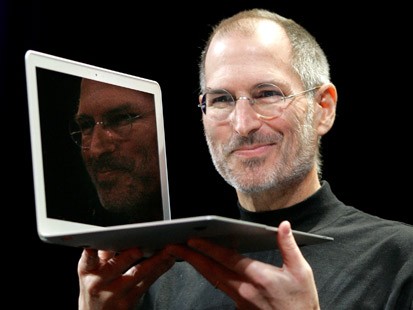The first computer I ever seriously used was an Apple II plus. It was also the first computer (other than the typesetters) acquired by the little weekly newspaper where I worked in Santa Barbara, CA. We agonized a bit between the Apple and the first-generation IBM PC. But a comparably equipped Apple was a bit cheaper and, for an alternative newspaper, more culturally appropriate than an IBM device. Plus, we could get VisiCalc, the first spreadsheet program, which was available only on the Apple.

I spent ungodly amounts of time with that computer, first setting up some basic financial reports for the paper and then creating — and personally populating — a historical content index using a primitive database program called DBmaster. Considering that I was probably the only person who ever used that index, it was something of a boondoggle, but I learned a lot, and pack rat that I am found it deeply satisfying to go through and document years of back issues.
Computingwise, my next weekly newspaper job was a step up. They were actually using computers rather than typewriters to compose and edit stories. We were equipped with Apple IIes, some even with dual five-and-a-quarter-inch floppy drives. That meant we could stop swapping in the Word Juggler program disk to run the program and a separate disk to save files. (At some point we acquired AppleWorks, the first office software suite I encountered, but Word Juggler offered superior word processing functionality.)

During this period I bought the first computer I personally owned, an Apple IIc. This was a portable evolution from the IIe, albeit with some enhanced features, including more memory (at least 128k) and better graphics. Unlike most personal computers of the time, this one actually looked like it had been designed. And the box was truly portable, even by later laptop standards, though that was because it had no built-in battery or display. The monitor was relatively transportable, but still a schlep to haul. I got the company to buy an extra one so I could have one display at work and one at home. The IIc came with one built-in floppy, and I added the external floppy drive to avoid the dreaded disk swap.
Not long after I bought it, the paper’s finance guy invited me into his office to show off his new, first-generation Macintosh. It was of course like no other computer I’d seen, not just because of the graphical UI, but also because it was the first (and ultimately one of the only) computers equipped with a keyboard that lacked arrow keys. That’s a usability faux pas we can lay personally on Steve Jobs, who believed people should use the mouse and not the keyboard to navigate. Of course it reflected his admirable – if in this case misguided – attention to detail. He eventually relented on the cursor keys, but as all Mac users know, to this day the company has bullheadedly refused to incorporate a standard delete key.
(I’d argue that Jobs’ genius lay most of all in his ability to make good choices across an overwhelming range of details. Most people in senior management eventually give up micromanaging both because of the resentment it breeds among colleagues and simple inability to keep up. It takes incredible focus, fabulous memory, and instincts that prove right nearly all the time, to sustain the kind of involvement that Jobs is credited with. Most of us surrender; he didn’t.)
Just a couple of years later, I left the Apple world for a long time to come. I acquired my first x86 computer, an IBM PC-XT hand-me-down from my brother equipped with a hard drive, all of 10 megabytes. I’m pleased to say that mostly I ran an early x86 variant of UNIX on that computer, only rarely booting DOS from a floppy.

I progressed to running DOS and later Windows, but when Jobs released a version of his Nextstep system ported to the x86 platform in 1993, I was excited. My brother had a Next cube so I had some idea of how well this UNIX-derived computer worked. Nextstep became my primary environment for the next year or so, including an MS Windows emulation application that wasn’t all that clunkier than current Parallels and VMware implementations. And just like a family trip to Hong Kong when I was 16 made it impossible for me to ever find a decent Chinese restaurant in the U.S., Nextstep for years made every graphical user interface seem woefully lacking. Its elegance, utility, and UNIX-based stability were far ahead of just about any 20th Century version of MS Windows. It was also clearly ahead of the old Mac OS, which sapped my motivation to switch back to Apple (along with the Mac’s second-tier software and driver support, apart from graphics and desktop publishing).
Unfortunately, Nextstep was a commercial dead-end and I fell squarely back into the PC camp. I did go through some iPods, however. Then, with the 2006 release of the MacBook Pro, I returned to the Apple fold, regretting only that I bought a travel-unfriendly 17” version. Since OS X was built on the foundation of Nextstep, I could finally have my cake and eat it too. The user interface remained way superior to Windows XP and Vista — more elegant, more empowering to the user, and simply more efficient.
I’m now on my second MacBook Pro, a 15” version. We still use the 17” in my house, and we also have what is certainly the nicest computer I’ve ever used, a Macbook Air, which dislodged my first IBM Thinkpad laptop as the computer I’ve come closest to loving. The Air is light, incredibly fast and lovely to behold. My next personal laptop will be the 13” Air; I’m just trying to hold out for a bigger solid-state drive.

Meanwhile, we also have three iPhones and two iPads, the second one being a unit I won in a trade-show raffle. I still have a pair of aging Windows PCs, and I’m not sure I’m prepared to live 100% Windows free. It would be like going entirely without network TV — it’s mostly dross, but I kind of want to keep in touch a little with that world. Plus, my work machine is a Windows notebook. And every time I touch a keyboard I’d rather be using a Mac, for which I can, of course, thank the late Mr. Jobs.

Nice. Have been trying to figure out what to write, too, and defaulting to mere tweets and Facebook shares for now. Did you see that Ebert tweeted he was reading about the death of Jobs on his 17th Mac? I’m not close, but then again I never succumbed to Wintel apostasy.